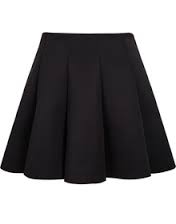skirt
英 [skɜːt]
美 [skɝt]
- n. 裙子
- vt. 绕过,回避;位于…边缘
- vi. 沿边走,绕开;环绕
CET4 TEM4 GRE 考 研 CET6
skirt 女裙,裙摆,挡板,裙板,环绕来自 shirt 对词形式,后产生词义上的分化,shirt 用于指男士衬衫,该词用于指女裙,裙摆, 并引申比喻义挡板,裙板,环绕等,如 outskirt,外围,郊区。
- skirt
- skirt: [13] Essentially skirt is the same word as shirt. It was borrowed from Old Norse skyrta ‘shirt’, which came from the same prehistoric Germanic source as English shirt, and likewise meant etymologically ‘short garment’. It is not clear why English came to use the word for ‘woman’s garment hanging from the waist’, but a link may be provided by modern Icelandic skyrta, which denotes a sort of long shirt with full tails that come down well below the waist. Swedish skört and Danish skørt ‘skirt’ were borrowed from the related Middle Low German schorte ‘apron’.
=> shear, shirt, short - skirt (n.)
- early 14c., "lower part of a woman's dress," from Old Norse skyrta "shirt, a kind of kirtle;" see shirt. Sense development from "shirt" to "skirt" is possibly related to the long shirts of peasant garb (compare Low German cognate Schört, in some dialects "woman's gown"). Sense of "border, edge" (in outskirts, etc.) first recorded late 15c. Metonymic use for "women collectively" is from 1550s; slang sense of "young woman" is from 1906; skirt-chaser first attested 1942.
- skirt (v.)
- c. 1600, "to border, form the edge of," from skirt (n.). Meaning "to pass along the edge" is from 1620s. Related: Skirted; skirting.
- 1. She wore a thick tartan skirt and a red cashmere sweater.
- 她穿了一条厚厚的格子呢裙和一件红色羊绒衫。
来自柯林斯例句
- 2. She idly pulled at a loose thread on her skirt.
- 她无聊地扯着裙子上一根松掉的线头。
来自柯林斯例句
- 3. This woman wore seamed nylons and kept smoothing her skirt.
- 这个女士穿着长筒尼龙缝袜,不停地把裙子弄平整。
来自柯林斯例句
- 4. She was wearing a white ruffled blouse and a blue velvet skirt.
- 她穿着一件有花边的白色上衣和一条蓝色天鹅绒裙子。
来自柯林斯例句
- 5. From her tiny waist a crinolined skirt cascaded in three deep tiers.
- 裙架撑起的三层大裥裙从她的纤腰上款款垂下。
来自柯林斯例句
[ skirt 造句 ]
